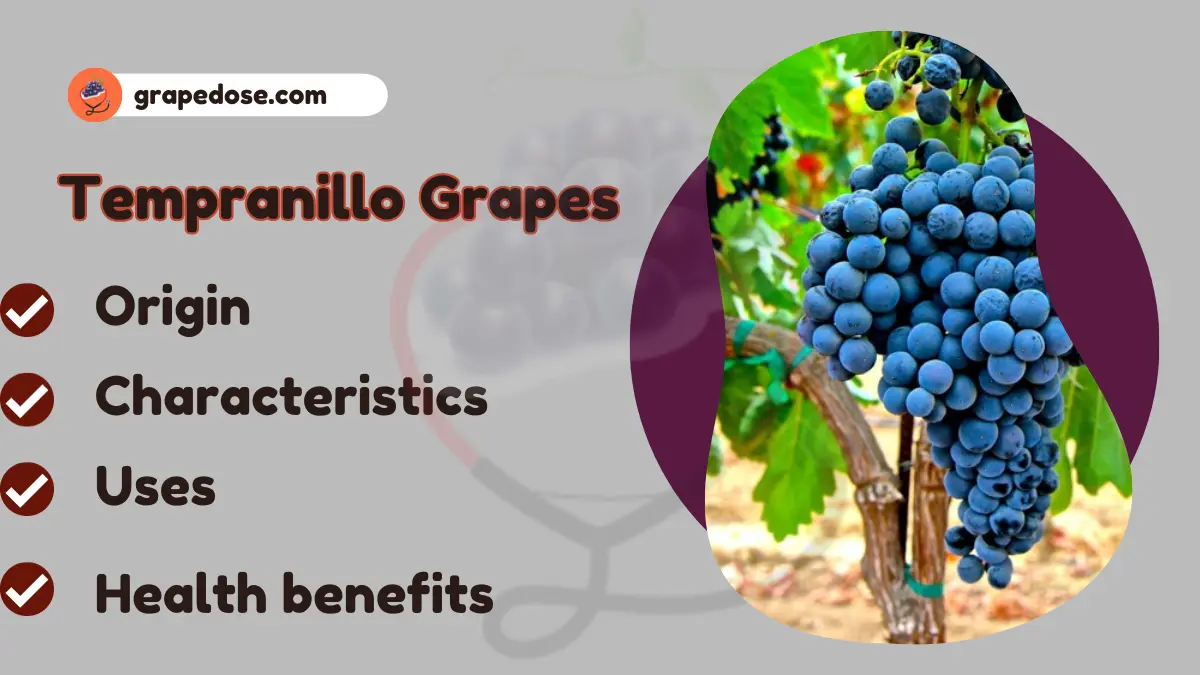In the vast world of wine, there are numerous grape varieties that contribute to the rich tapestry of flavors and aromas. One such grape that has been gaining increasing recognition and popularity is the Tempranillo grape. [1]
With its deep roots in Spain and the promise of an exquisite drinking experience, Tempranillo grapes are a true delight for wine enthusiasts.
In this article, we will delve into the history, characteristics, and the remarkable journey of Tempranillo grapes in the world of winemaking.

Origin of Tempranillo
Tempranillo grapes often referred to as the “noble grape of Spain,” has been cultivated in the Iberian Peninsula for centuries.
Its history is traced back to the Roman era, where it was initially known as “Tinto del Pais.”
This grape’s name, “Tempranillo,” is derived from the Spanish word “temprano,” meaning “early,” which reflects its early ripening nature.
Characteristics of Tempranillo Grapes

- They offer flavors of red fruits, plum, cherry, and sometimes vanilla or tobacco.
- Tempranillo wines have a moderate to full-bodied structure.
- They typically have balanced acidity, making them food-friendly.
- Tempranillo is a key grape in Spanish wines, like Rioja and Ribera del Duero.
- These grapes produce wines that age well, developing complex flavors over time.
Uses of Tempranillo Grapes
- Tempranillo is used to create a range of table wines, offering diverse flavor profiles to suit different preferences.
- Tempranillo wines often age well, developing complex flavors and aromas over time, making them suitable for cellaring.
- Tempranillo is sometimes blended with other grape varieties to create unique wine blends, such as in Rioja wines.
- Tempranillo wines pair well with a variety of foods, particularly Spanish cuisine, including tapas, roasted meats, and cheese.
- Spanish Tempranillo wines are exported worldwide, introducing this grape to a global audience.
- Tempranillo’s popularity has contributed to wine tourism in regions like Rioja and Ribera del Duero, attracting visitors to vineyards and wineries.
Health Benefits of Tempranillo Grapes

1: Antioxidants
Tempranillo grapes are rich in antioxidants like resveratrol, which may help protect cells from damage and reduce the risk of chronic diseases.
2: Heart Health
Moderate red wine consumption, including Tempranillo, has been associated with a lower risk of heart disease due to its potential to improve cholesterol levels and promote cardiovascular health.
3: Anti-Inflammatory
Some compounds in Tempranillo wine may have anti-inflammatory properties, which benefit overall health.
4: Blood Sugar
Limited research suggests that moderate red wine consumption may help regulate blood sugar levels.
5: Longevity
Some studies indicate that resveratrol in red wine, including Tempranillo, might contribute to longevity by promoting cellular health.
Tempranillo grapes offer a remarkable journey through the world of wine, with their rich history, diverse characteristics, and international allure. These grapes have solidified their place as a wine lover’s delight, providing a wide array of options for those seeking a distinctive and satisfying wine experience.
Frequently Asked Questions
What foods pair best with Tempranillo wines?
Tempranillo wines pair excellently with a variety of dishes, including grilled meats, paella, and aged cheeses.
Can I age Tempranillo wines for an extended period?
Yes, Tempranillo wines are known for their aging potential. Some premium bottles can be cellared for 10 years or more, developing complex flavors and aromas.
Are there any specific regions outside of Spain known for outstanding Tempranillo wines?
Yes, regions in Portugal, Australia, and the United States have gained recognition for their Tempranillo wines, offering unique expressions of this grape.
What’s the ideal serving temperature for Tempranillo wines?
Tempranillo wines are best enjoyed at temperatures ranging from 60°F to 68°F (15°C to 20°C), depending on the wine’s style and age.
Are there any specific glassware recommendations for serving Tempranillo wines?
It’s best to use a wine glass with a large bowl and a tapered top to capture the wine’s aromas and allow it to breathe.

